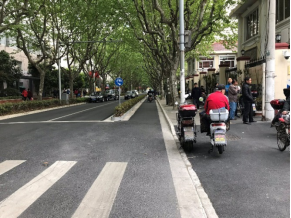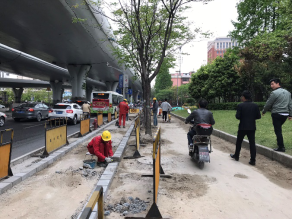Improving Non-Motorized Transport Facilities for a Safer and Greener City: A Case Study on Shanghai's Yangpu District
2018.12.10
28fafd61-66fd-4fdb-ab37-3e72d6f73340.png)
By Alina F. Burlacu and Geoffrey John Kurgan
Designing safer roads for all users and creating a forgiving and self-explaining environment is a priority in World Bank financed road projects. There are numerous tools that can be applied to identify risks and improve road safety infrastructure during implementation – road safety inspections, road safety audits, International Road Assessment Programme (iRAP) baseline and design evaluations, black spot management programs, etc.
Under the Bloomberg Initiative for Global Road Safety, the World Bank’s Global Road Safety Facility is working together with iRAP, the World Resources Institute, and relevant stakeholders in Shanghai. One of the local agencies leading the away is the Yangpu Transport Commission, which is looking at how to eliminate 1- and 2- star1 streets that exist within their network. This story looks at some of the ways that the transport commission is improving non-motorized facilities to make Yangpu District’s streets safer and greener and ultimately more livable.
The engagement in Shanghai started by using a large-scale neighborhood infrastructure renovation program as the vehicle to introduce improved road safety countermeasures. Significant interfacing with ChinaRAP (the team responsible for developing the Chinese adaptation of the iRAP methodology and delivering related services), the Road Affair Bureau, the Shanghai Transportation Commission, the Shanghai Institute of Transportation Engineers, the Hongkou District Bureau of Construction, and Tongji University resulted in the development of a work plan that included two urban corridor demonstration projects. Later in the year, a substantial step was taken when Anting Township agreed to be a second demonstration area for a township-wide assessment of approximately 50km, which included major arterials and connecting streets.
Through extensive discussions with the Shanghai Yangpu Transport Commission and Yangpu District Traffic Police, three roads and one network totaling 100km in Yangpu District were selected for iRAP assessments and development of road safety infrastructure recommendations. At the same time, post-construction iRAP assessments of two pilot roads (Zhengtong and Jungong Roads – photos below) were undertaken. Many of the recommendations provided were integrated into the designs and construction, particularly for vulnerable road users (pedestrians, cyclists, motorcyclists, and e-bike users), which cannot withstand impact from a motor vehicle moving above 30-40 km/hr. Road safety infrastructure interventions focused on segregating motor vehicles and vulnerable road users, providing better pavement delineation and signing, as well as enhancing intersections to help slow down motorists and create safe refuge spaces for pedestrians. The result of investing in these interventions at an approximate cost of RMB83,825,865 (approximately USD12,511,323) is a reduction of 243 deaths and serious injuries over 20 years for the 100km of roads and a savings of RMB209,840,581(approximately USD31,319,490) in crash costs at a benefit-cost ratio of 3. These improvements were captured in the before and after scenes found in a video of the transformation of Zhengtong Road.


Figure: Infrastructure upgrades in Yangpu District (Zhengtong Road – left; Jungong Road Northbound – right), Shanghai, April 18, 2018
Yangpu District is now considering expanding iRAP or ChinaRAP assessments to support eliminating 1- and 2- star roads in the future. A similar engagement is also ongoing in Jiading District. Finally, there are discussions on expanding towards a third district with different traffic characteristics, to have a comprehensive review of road safety problems and solutions in Shanghai. These engagements could result in establishing best practices for network-level screening of infrastructure risks and road safety interventions using the ChinaRAP methodology.
1 The iRAP approach evaluates a number critical factors that are known to impact the potential for and severity of road crashes. The methodology establishes a risk score and star rating with one being the worst and five being the best (safest).



